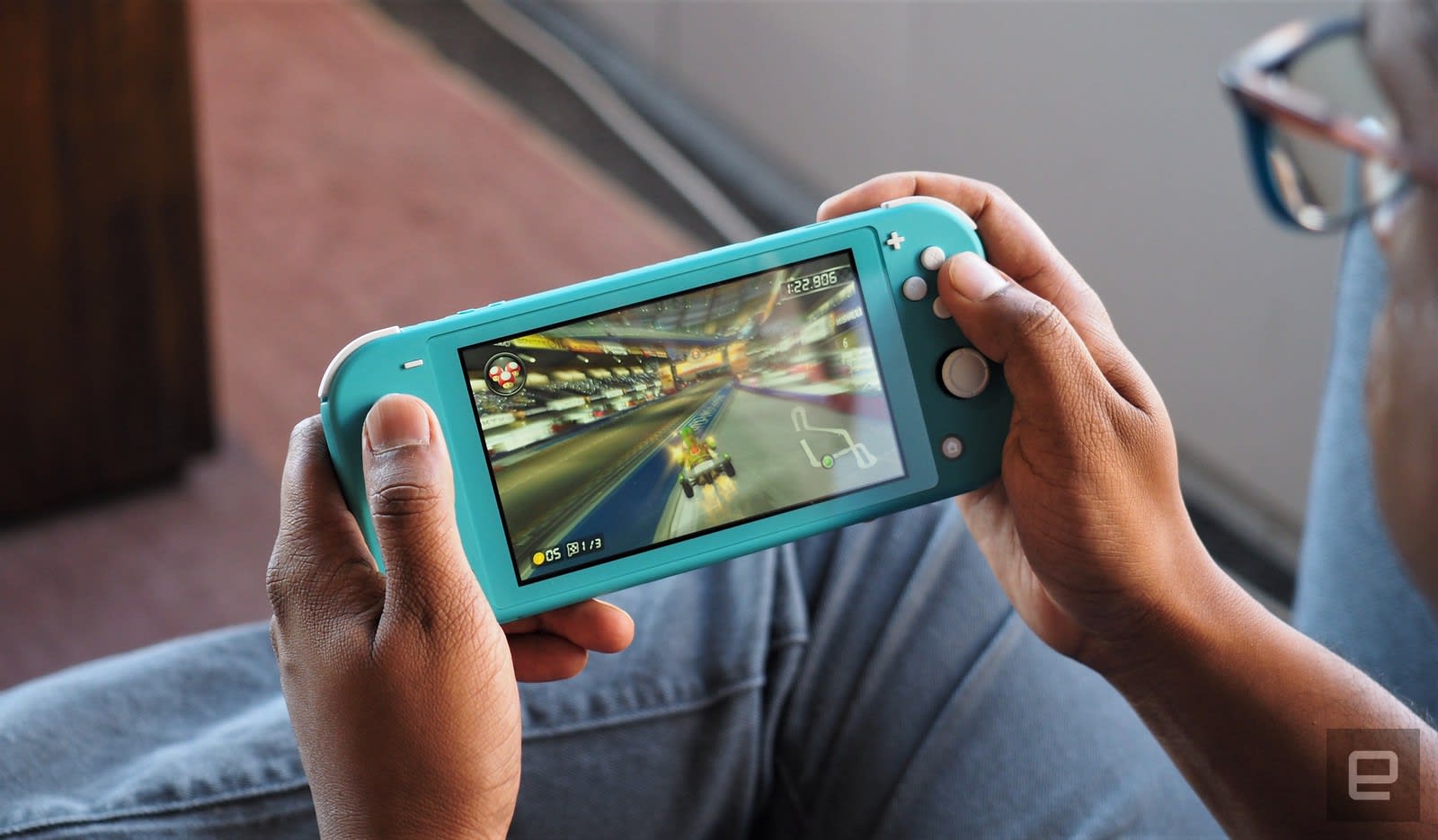The is nearly here, which means the original Switch is entering its twilight years. It’s been eight years since Nintendo released its , and while many fans have spent the last couple of those itching for the device to be replaced, now seems like an opportune time to look back at what its legacy may wind up being (while acknowledging that it still has some life ahead of it).
Instead of bleating on myself, though, I turned to the rest of the Engadget staff to see what comes to mind when they think of the Switch, as just about everyone on the team has played with the console. We’ve collected our reflections below — some take a bigger-picture view, some are more personal, some contradict others’ experiences entirely. There’s plenty more that went unsaid. But I think that’s part of the Switch’s beauty; it’s a device that’s resonated with so many, in so many different ways, in its near-decade on the market.
The Switch embodied Nintendo’s lateral thinking with withered technology
Broadly speaking, you can group Nintendo consoles into two types. On one side you have devices that may be distinctive in certain ways but mostly iterate on a previous success or focus on technical upgrades first — think the SNES, GameCube, Game Boy Color, Game Boy Advance, 3DS and, by the looks of it, the Switch 2. (The N64 and original NES could go either way, but I’d put them here too.) On the other you have machines that are more out there, ones that most obviously represent “lateral thinking with withered technology,” the company’s longtime product philosophy championed by legendary designer .
These eschew cutting-edge technology for mature, cheaper hardware redeployed in novel ways. The worst of these have been existential disasters for Nintendo (Wii U, ). The best have created new forms of play, experiences you could hardly imagine before but make perfect sense in hindsight (Game Boy, DS, Wii). Not coincidentally, these are the consoles that’ve in Nintendo’s history.
The Switch fell firmly in the latter camp. It didn’t really matter that the chip was from an . It didn’t really matter that the Joy-Cons kind of sucked, with beady buttons and thumbsticks that . It didn’t matter that there was a paltry 32GB of storage, that the (non-OLED) display was barely usable outdoors, that the triggers weren’t pressure-sensitive or that the kickstand always felt like it’d snap off. In a world that, for better or worse, increasingly demands comfort above all else, it won on sheer force of convenience. No other gaming device had ever gone so far to meet players where they live. And it won on , as Nintendo systems often do. Like the Game Boy and Wii, the Switch’s concept was so undeniable that its hardware only needed to be good enough for its time in the sun. So that’s all it ever was. It embodied Nintendo’s lateral thinking, blending unremarkable parts into something playful and brilliant. — Jeff Dunn, senior reporter
The Switch saw Nintendo (finally) embrace indies
The Switch was an absolute delight for fans of indie game studios. This was really the first time the company truly embraced smaller developers in a comprehensive way, and it paid off big. The console became the de facto way to experience many of the standout titles of the past generation, including stuff like Celeste, Dead Cells, Hades, Golf Story, Undertale, Stardew Valley and, of course, Hollow Knight.
The hybrid nature of the console led many gamers, myself included, to wait for a Switch release of an indie title. This was before the Steam Deck and its ilk, so there really wasn’t any other way to play most of these games on a portable machine. The company’s sudden support for indies was great for gamers, as we got to play cool stuff, but it was also great for Nintendo. Many of these titles and gave the company some breathing room between first-party releases. Remember, the Switch was woefully underpowered when compared to other consoles so it couldn’t really run many AAA third-party games. Nowadays, Nintendo loves indies so much that they get their own Direct livestreams. My, how times have changed. — Lawrence Bonk, contributing reporter
The Switch was a haven for the golden age of Metroidvanias
It’s fitting that will be the Switch’s swan song. Starting with the release of Hollow Knight a year after the system’s debut, the Switch has been the best place to experience the golden age of Metroidvanias. Between , Blasphemous 2, Hollow Knight, Nine Sols and Nintendo’s own contributions to the genre, nearly every great Metroidvania since 2017 has made it to the Switch; in fact, Microsoft even on the console.
The Switch was my favorite place to play many of those games. With their often simpler graphics, most Metroidvanias were a perfect fit for the system. For example, Hollow Knight and run at a flawless 60 frames per second and look great on the system, especially on the with its ability to produce inky blacks. The Switch’s portability is also a huge boon for these types of games. They’re great for short pick up and play sessions, and even better for longer ones when you can get lost in their worlds. — Igor Bonifacic, senior reporter
In praise of the Switch Lite, the handheld console for everyone

When I think of the Switch, the first object that comes to mind is my coral . No fancy OLED screen, no detachable controllers, no TV input mechanism and a maximum resolution of 720p, all wrapped up in an adorable, handheld, candy-colored package. For me, this is a highlight of the ninth console generation. The Switch Lite is effective because it’s simple: It comfortably fits in most people’s hands (ahem, ), it offers a large selection of indie and mainstream games, its screen is just big enough, it travels well and it’s cute as hell. The audience for the Switch Lite spans children to adults, commuters to work-from-homers, and its popularity demonstrates some deep truths about what we actually love in video games. Turns out, photorealistic graphics and uncapped framerates are less important than solid game design and innovative mechanics.
I’ve owned a full-fat Switch and a Lite for years, and while I enjoy playing Mario Kart 8 with friends on the couch, nothing beats the intimacy of curling up with my little Lite. Perhaps it’s not surprising that Nintendo, the creator of the Game Boy and its numerous iterations, knows how to make a fantastic handheld console, but it’s still supremely satisfying. I’m excited about the Switch 2, sure, but the debut console — , detachable gamepads and all — is only responsible for half of that feeling. The other half is on pause and smothered in pastels, patiently waiting on the announcement of a Switch 2 Lite. — Jessica Conditt, senior editor
The Switch is a lesson to all developers, everywhere
Ever since I’ve been able to see how much memory a single Chrome tab uses, I’ve been obsessed with elegance. Not in the ballgowns-and-tuxedos sense, but to pursue efficiency as a form of art, to use self-imposed limitations to surpass anyone’s expectations. It may have been a brightly-colored games console, but the Nintendo Switch was a masterpiece of elegance.
It’s not that modern-day Nintendo has ever really gotten into the bigger-number-is-better wars but then, as now, people were sniffy about the Switch’s power. After all, it was using a modified and, crucially, downclocked version of NVIDIA’s Tegra X1 system on chip. It wasn’t long before everyone started (kinda) joking their smartphones could beat the console in the power metrics.
Compared to the competition? Pfft. The Xbox and PS4 were smog-billowing big rigs next to the Switch’s carbon-fiber bicycle with only one crossbar. And yet, of the three, it’s the console I’ve spent the most time playing during this whole generation. Because for all it lacked in graphical clout, it never seemed to miss out where it counted.
That’s testament to Nintendo squeezing so much damn power out of the Switch, and its willingness to put the work in. Yes, you can get Call of Murder Simulator with ultra-realistic blood spatter on the other two consoles, but it’s not as if there weren’t plenty of demanding titles on this platform too. I can call to mind games like Doom Eternal and , not to mention top-tier games from the last generation, like Bioshock and Portal.
And that’s before you got to masterpieces like and which are, shockingly good given the hardware they’re running on. Yes, there was the odd frame drop in the latter title, but when you think about what that game was doing, a frame drop was more than forgivable. Fundamentally, the Switch is a lesson to all developers everywhere that they should be disciplined to do a lot more with a lot less. — Daniel Cooper, senior editor
The Switch had me dreaming of a higher-fidelity Hyrule
Apologies in advance if this comes off as another gamer saying Nintendo should make more powerful consoles. That’s not what I’m saying, I swear. Nintendo hasn’t chased the PlayStation or Xbox in graphics power for multiple console generations; it clearly has different priorities. And the art style and attention to detail in its first-party games is nearly unmatched. Rarely have I played any of Nintendo’s games and thought “this could use more pixels” or more “realistic” graphics.
However, in late 2017 I was engrossed in two games: Horizon Zero Dawn on the PS4 and The Legend of Zelda: Breath of the Wild for the then recently released Switch. As fate would have it, both games came out in March, and while Horizon got plenty of positive reviews, it was a bit buried by the hype around Breath of the Wild and its radical reinvention of how a Zelda game plays. And while the two have their fair share of differences, the commonality of exploring a gorgeous and vast open world where you could go to almost anywhere you can see made me think how much I’d love it if Nintendo went all-in on a console and Zelda title that could provide fidelity like in Horizon Zero Dawn.
I’m not saying I need human-realistic characters in a Zelda game — the art direction in Breath of the Wild is great. But the forests, mountains, deserts, caves and rivers in Horizon are perhaps the most beautiful rendering of the natural world that I’ve ever seen in a game. Combining the endless exploration of Hyrule in Breath of the Wild with a Hyrule that looks as good as the world in Horizon does would be an incredible combo, even though it’s not something I’m holding my breath for. That said, the Switch 2 seems like a much more capable console, and you have to imagine the next Zelda game will look a bit different than the last two. Surprise me, Nintendo! — Nathan Ingraham, deputy editor
The Switch changed me from Nintendo skeptic to Nintendo superfan
Before the Switch came out, I knew there were people who proudly wore their Nintendo fandom, but I could not understand their fascination. I think that was because I'd never had my own Nintendo hardware. Every experience I'd had of the company's games before the Switch was on a console that belonged to a friend, roommate or significant other. That meant as a player, my experience was almost entirely based on casual hangout games like Mario Kart and Mario Party. Later on, as I began writing about games, my professional opinion was that Nintendo made money by manufacturing scarcity with limited releases and a dubious attitude about preservation.
Given all the mid-to-bad feelings I had about the company, I don't remember why I decided to buy a Switch for myself. It was about a year after the hardware debuted, so maybe I'd seen enough positive buzz that I was ready to see what all the fuss was about. Whatever the reason, I'm so happy I wandered into the store to finally acquire my first Nintendo console that fateful day.
Since then, I've spent hours in , gleefully searching every corner of each world for sneaky hidden moons. I logged even more time in Breath of the Wild, exploring Hyrule as an escape from the doom of COVID in the real world. I've logged multiple hundreds of hours uncovering the intrigues of Garreg Mach Monastery and leading my students into battle with . And you don't even want to know how many hundreds of hours I've spent clearing out pills in Dr. Mario. A bunch of titles that I'd now consider my favorites came from my time playing on the Switch.
I'm sure that if the SNES or the N64 had been my true introduction to the world of Nintendo, I'd have similar warm fuzzies about those generations of games. But the way my timeline has gone, the Switch is the one that introduced me to this joyful and delightful gaming ecosystem. So I see you, Nintendo fans. And now I am one of you. — Anna Washenko, contributing reporter
The Switch was the console I always wanted – until it wasn’t
I was desperately hoping for a console like the Switch before it was announced by Nintendo. That time, I was mainly gaming on the Nintendo 3DS and the PS Vita, until I discovered the Vita TV and realized that I prefer being able to play my handheld games on a bigger screen sometimes. I remember playing Fire Emblem Awakening on the 3DS and thinking of how it would be so much better if I could get a bigger view of the battlefield.
When Nintendo released the Switch years later, it was everything I wanted. You can take your game with you anywhere and then play it on the TV when you're home? Perfect. The Vita TV wasn't as seamless, since I had to move memory cards to and from the handheld Vita to play the same game.
Now, years later, my life and my eyesight have gone through some big changes. I no longer play games if I can't play them on the TV. That means for games that have both a Nintendo and a PlayStation version, I almost always get the one for PlayStation, since it has better graphics and overall quality.
But what about Nintendo-exclusive games? These days, I find myself wishing for a Switch without a screen. Just a simple console like the Vita TV with, perhaps, better specs for crisper graphics and less stuttering. Or, if that's truly not possible, just one that's cheaper than the full console. (I’m person who’s called for this!) Alas, there's no version of the Switch 2 coming out without a display. It's a wish I may have to carry with me for years like my wish for the Switch's current form factor — I'll just have to wait and see if it also comes to life. For now, I'll just keep on playing on my (docked) Switch. — Mariella Moon, contributing reporter
The Switch helped make handhelds feel special again
I got my Nintendo Switch on launch day way back in March 2017 and it's the only one I've ever owned. And even though its Joy-Con started to drift over the years and its Nvidia Tegra X1 chip was already kind of dated from the get-go, I will always appreciate how that thing held it down for the better part of a decade. Plus, thanks to Nintendo's magic, it never felt like the console was held back by its less powerful hardware.
However, as we begin the transition to its successor, I really want to praise the Switch for reinvigorating people's interests in handhelds. When it came out, the Nintendo 3DS was already on its last legs while Sony had all but abandoned the Vita. But thanks to the Switch's ability to double as both a home console and a portable gaming device, it directly paved the way for so many of on sale today like the , Steam Deck and more. This reminds me of how awesome it felt as a kid to bring games with me to help pass the time on long road trips or when the dentist would distract me with a Game Boy during cleanings. It's something that still feels special today even with the proliferation of laptops and tablets, which can't quite match that level of engagement and portability, and I will forever appreciate the risk Nintendo took when it designed that flexibility into the Switch's core identity. — Sam Rutherford, senior reporter
This article originally appeared on Engadget at https://www.engadget.com/gaming/nintendo/reflections-on-the-nintendo-switch-the-hybrid-console-that-changed-gaming-192049755.html?src=rss
Credit: Source link









































